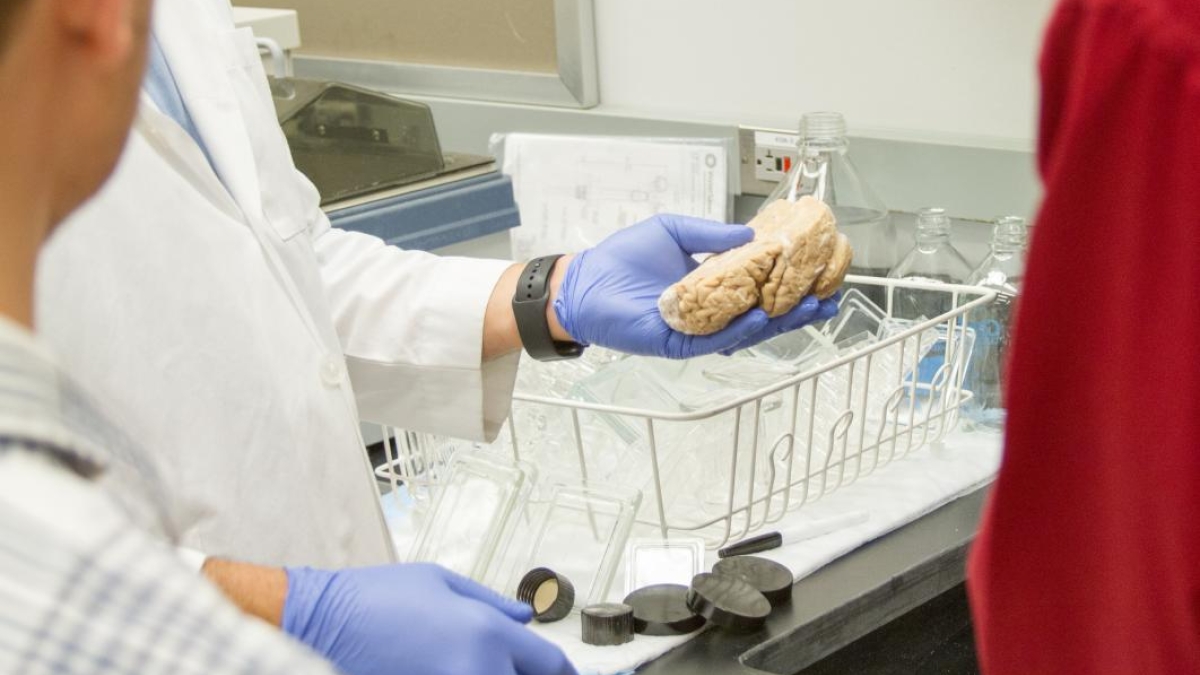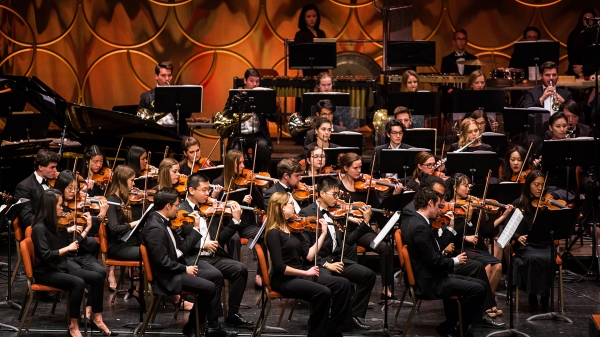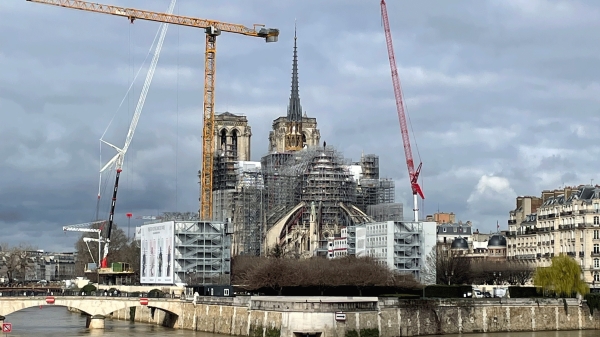ASU Design and Arts Corps trains designers, artists to work with communities
One of the Herberger Institute’s signature initiatives, Design and Arts Corps aims to become a national model for arts- and design-led community change

Last fall, two Design and Arts Corps students from the School of Music visited brain banks and labs with ASU neuroscientists studying Alzheimer’s disease. Photo by Gavin Maxwell/Biodesign Institute
Schools. Hospitals. Laboratories. Designers and artists do as much work outside their practice rooms and studios as they do inside those traditional spaces.
Courtney Davis, an interior architecture graduate student in Arizona State University’s The Design School, has spent the bulk of her semester this spring in the Sunnyslope community of Phoenix working with Chrysalis, a nonprofit that supports survivors of domestic abuse.
“I’m working with them to redesign a transitional housing casita for families who have moved through the emergency shelter but need housing while seeking education and job training,” Davis said. “I love knowing this design will support these strong mamas and resilient kids.”
Her project is one of several that place designers, artists and design and arts scholars and educators in public life as part of the Design and Arts Corps in ASU’s Herberger Institute for Design and the Arts.
One of the Herberger Institute’s signature initiatives, Design and Arts Corps aims to become a national model for arts- and design-led community change. Through partnering with communities, the initiative not only places student designers and artists in public life but also trains and prepares them to be community practitioners — to use their creative capacities to advance culture, strengthen democracy and imaginatively address today’s most pressing challenges.
Leveraging creative skills
The Design and Arts Corps addresses a unique 21st-century challenge for design and arts colleges. About 85 percent of design and arts graduates worked outside of the arts at some point in their careers, according to a national survey of more than 80,000 design and arts alumni. Schools do not train design and art students to leverage their creative skills to serve in nontraditional settings like health care, youth development, faith communities, civic institutions and social profit organizations. Design and Arts Corps does.
“This initiative fundamentally shifts design and arts education to ensure that every student gets a chance to work with a community partner and to deeply understand how they can equitably use their creative talents and imaginations to improve their communities,” said Stephani Etheridge Woodson, director of Design and Arts Corps.
For example, a digital storytelling program called iCreate partners Design and Arts Corps students with Phoenix Children’s Hospital. The resident artists work with young patients to create playful explorations of the children’s most creative selves. Patients get to dance in space or travel around the world or vanquish volcano monsters in these videos, which helps them build creative capacities, reduce stress responses and strengthen psychological resiliency.
Last year, two graduate students from the School of Music visited brain banks and labs with ASU neuroscientists studying Alzheimer’s disease as part of a Design and Arts Corps project. Through original compositions, the students communicated the research they observed and the struggles affecting Alzheimer’s patients, caregivers and the scientists searching for a cure.
In the fall, students from The Design School joined the School of Sustainability’s Project Cities partnership with the city of Apache Junction. Landscape architecture students working with Professor Kenneth Brooks helped create land use maps and made recommendations to the city on several projects, including creating an off-leash dog park and improving solid waste and recycling. Also, Assistant Professor Danielle Foushee and a research class teamed up with the city of Tempe for “Arts in the Park,” which continued this spring with students from the Socially Engaged Design and the Arts class.
This semester, film students in Lecturer Gene Ganssle’s class are partnering with local nonprofit organizations to create PSAs. An art student is working on a public art project with 16- to 24-year-olds who are disconnected from work and school. A design student and a sustainability student are partnering to design and offer a workshop inspired by the meaning-making theories of logotherapy, developed by Victor Frankl, who was a psychiatrist and Holocaust survivor. The workshop brings together theater performance with interactive games aimed at helping visitors find a sense of meaning, even in difficult times.
For her project with Chrysalis, Davis said she is thrilled to leverage the design principles she’s learned at ASU.
“The challenge, and what I get really excited about as a designer, is using principles of trauma-informed care, and biophilia to create spaces that are not only functional, but actually contribute to healing and transformation,” Davis said. “Beauty is care, and design makes a powerful contribution to healing.”
Working together
One of the primary goals of the Herberger Institute’s Design and Arts Corps is not just giving the students the opportunity to contribute to their communities, but also making sure they are trained to be ethical partners.
“In a traditional process, a designer like myself might come in and play the expert,” Davis said. “In this project, I am working closely with the organization, as well as getting input from the residents about what the spaces need. There is a lot of give and take.”
Herberger Institute alum Julie Akerly, who serves as the arts engagement specialist for the city of Tempe, sees the need for this kind of training.
“It is important for artists to learn how to work with communities, especially as the arts play a larger and larger role in supporting the equity and inclusion of communities,” she said. “As someone who works in arts engagement, we are often interested in hiring artists to do community-based work and to work with communities in Tempe, but it is hard to know who has the skills to address communities in a way that will not be harmful.”
Design and Arts Corps received funding from the Lincoln Center for Applied Ethics to build the ethics component of the initiative along with help from a community advisory council. Current plans include a certification that Design and Arts Corps students will complete before they go out into the communities.
“There will be a piece on equitable communications, one on democracy since this is a democratically engaged community, and then a module on the theory of change,” Etheridge Woodson said.
Changing the world
When Steven J. Tepper, dean of the Herberger Institute, joined ASU, he knew he wanted to launch the Design and Arts Corps initiative, and he knew the impact it could have.
“Artists and designers have a way of asking questions, expanding our imagination and exploring opportunities,” Tepper has said. “Their ideas and methods provide a powerful lens to address critical issues facing our communities, and they should be fully integrated into public life rather than seen as extra or special or something apart from everyday life.”
Through Design and Arts Corps, students will be able to do just that — address critical issues facing our communities.
“I was drawn to Design and Arts Corps because I feel passionate that everyone is deserving of beautiful, functional spaces, regardless of their race, religion, gender or economic status,” Davis said. “This was the perfect opportunity to create a space that has a positive and very concrete impact on the life of a family.”
And when Davis leaves ASU, she will take the necessary skills and knowledge to continue this work and make an impact with her into the wider world. She’ll be one of many.
“Once we’re fully rolled out, every Herberger Institute student will participate in Design and Arts Corps at least one time while at ASU,” Etheridge Woodson said. “We will probably have 1,600 students per academic year working in partnership with community, which will make us the largest socially engaged design and arts program since the Works Progress Administration in the 1930s.”
The echoes of the Works Progress Administration are not accidental. Dean Tepper certainly has it mind when he says: “The nation is asking us how can we lead — how can we show the way forward so that every artist and designer who graduates in America recognizes they have the tools, the capacity, the imagination, the competencies to work anywhere, in any place, with any partner, to engage, to advance ideas, to solve problems, to build communities, to create a more equitable world. That is what our mandate is.”
More Arts, humanities and education

Small press dealt big blow
A mighty rumble reverberated throughout the publishing industry late last month with the abrupt closure of a well-known book…

ASU Symphony Orchestra welcomes visionary conductor Jonathan Taylor Rush
Guest conductor Jonathan Taylor Rush will join Arizona State University’s Jason Caslor, director of bands, to lead the ASU…

Chemistry classes are key to art student's success
Amanda Barnette has a passion for art preservation. That means that, for the past four years, the Arizona State University…